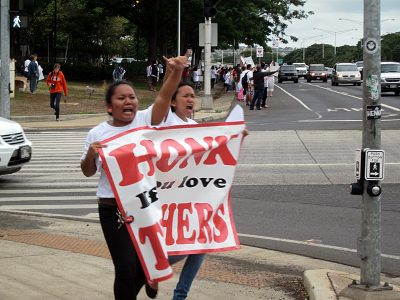Under siege—and in bid to stay relevant—teacher unions evolve
HONOLULU — The Hawaii State Teachers Association’s weekly briefing meeting had turned into a battle-planning session; the conference room became a war room. It was late November. Officials were digging in for a protracted fight with the state over teacher evaluations and compensation.
They were also dealing with an internal problem: A rogue group of frustrated teachers had launched a “work-to-rule” campaign without union leaders’ approval, and they had to figure out how to respond.
Hawaii has traditionally been one of the most labor-friendly states in the nation. Collective bargaining is written into its constitution, and more than a fifth of its workforce belongs to a union. Only New York and Alaska have higher union-membership rates. A 2012 study by the Thomas B. Fordham Institute, a conservative education think tank, ranked the Hawaii State Teachers Association (HSTA) as the strongest teachers union in the country.
But by last November, Hawaii’s 13,000 teachers had reached a breaking point. They had been working without a negotiated contract for more than 16 months. For two years, the union and state had fought over pay, benefits and a new teacher evaluation plan. Defying the union, the governor-appointed Board of Education mandated a
They were also dealing with an internal problem: A rogue group of frustrated teachers had launched a “work-to-rule” campaign without union leaders’ approval, and they had to figure out how to respond.
Hawaii has traditionally been one of the most labor-friendly states in the nation. Collective bargaining is written into its constitution, and more than a fifth of its workforce belongs to a union. Only New York and Alaska have higher union-membership rates. A 2012 study by the Thomas B. Fordham Institute, a conservative education think tank, ranked the Hawaii State Teachers Association (HSTA) as the strongest teachers union in the country.
But by last November, Hawaii’s 13,000 teachers had reached a breaking point. They had been working without a negotiated contract for more than 16 months. For two years, the union and state had fought over pay, benefits and a new teacher evaluation plan. Defying the union, the governor-appointed Board of Education mandated a

